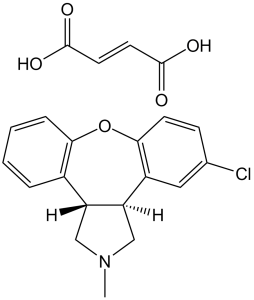Asenapine maleate (Org 5222 maleate)
This product is for research use only, not for human use. We do not sell to patients.

For small sizes, please check our retail website as below: www.invivochem.com
| Size | Price | Stock |
|---|---|---|
| 2g | $1350 | Check With Us |
| 5g | $2150 | Check With Us |
| 10g | $3225 | Check With Us |
Cat #: V1097 CAS #: 85650-56-2 Purity ≥ 98%
Description: Asenapine maleate (Org5222; Org-5222; HSDB-8061; HSDB8061; Saphris and Sycrest), an atypical antipsychotic, is a potent and high-affinity antagonist of serotonin, norepinephrine, dopamine and histamine receptors.
Top Publications Citing Invivochem Products
Publications Citing InvivoChem Products
Product Promise

- Physicochemical and Storage Information
- Protocol
- Related Biological Data
- Stock Solution Preparation
- Quality Control Documentation
| Molecular Weight (MW) | 401.84 |
|---|---|
| Molecular Formula | C17H16ClNO.C4H4O4 |
| CAS No. | 85650-56-2 |
| Storage | -20℃ for 3 years in powder formr |
| -80℃ for 2 years in solvent | |
| Solubility In Vitro | DMSO: 80 mg/mL (199.1 mM)r |
| Water: <1 mg/mLr | |
| Ethanol: <1 mg/mL | |
| Synonyms | Org 5222; HSDB 8061; Org 5222; HSDB 8061; Org5222; Org-5222; HSDB-8061; HSDB8061; Asenapine; Asenapine maleate; trade names Saphris and Sycrest. |
| Protocol | In Vitro | Relative to its D2 receptor affinity, asenapine has a higher affinity for 5-HT2C, 5-HT2A, 5-HT2B, 5-HT7, 5-HT6, α2B and D3 receptors, suggesting stronger engagement of these targets at therapeutic doses. Asenapine behaves as a potent antagonist (pKB) at 5-HT1A (7.4), 5-HT1B (8.1), 5-HT2A (9.0), 5-HT2B (9.3), 5-HT2C (9.0), 5-HT6 (8.0), 5-HT7 (8.5), D2 (9.1), D3 (9.1), α2A (7.3), α2B (8.3), α2C (6.8) and H1 (8.4) receptors |
|---|
These protocols are for reference only. InvivoChem does not
independently validate these methods.
| Solvent volume to be added | Mass (the weight of a compound) | |||
|---|---|---|---|---|
| Mother liquor concentration | 1mg | 5mg | 10mg | 20mg |
| 1mM | 2.4886 mL | 12.4428 mL | 24.8855 mL | 49.7711 mL |
| 5mM | 0.4977 mL | 2.4886 mL | 4.9771 mL | 9.9542 mL |
| 10mM | 0.2489 mL | 1.2443 mL | 2.4886 mL | 4.9771 mL |
| 20mM | 0.1244 mL | 0.6221 mL | 1.2443 mL | 2.4886 mL |
The molarity calculator equation
Mass(g) = Concentration(mol/L) × Volume(L) × Molecular Weight(g/mol)
Mass
=
Concentration
×
Volume
×
Molecular Weight*
The dilution calculator equation
Concentration(start)
×
Volume(start)
=
Concentration(final)
×
Volume(final)
This equation is commonly abbreviated as: C1 V1 = C2 V2
Concentration(start)
C1
×
Volume(start)
V1
=
Concentration(final)
C2
×
Volume(final)
V2
Step One: Enter information below
Dosage mg/kg
Average weight of animals g
Dosing volume per animal µL
Number of animals
Step Two: Enter the in vivo formulation
%DMSO
+
%
+
%Tween 80
+
%ddH2O
Calculation Results:
Working concentration:
mg/ml;
Method for preparing DMSO master liquid:
mg
drug pre-dissolved in
µL
DMSO(Master liquid concentration
mg/mL)
,Please contact us first if the concentration exceeds the DMSO solubility of the batch of drug.
Method for preparing in vivo formulation:
Take
µL
DMSO master liquid, next add
µL
PEG300, mix and clarify, next add
µL
Tween 80,mix and clarify, next add
µL
ddH2O,mix and clarify.
Note:
- (1) Please be sure that the solution is clear before the addition of next solvent. Dissolution methods like vortex, ultrasound or warming and heat may be used to aid dissolving.
- (2) Be sure to add the solvent(s) in order.




































